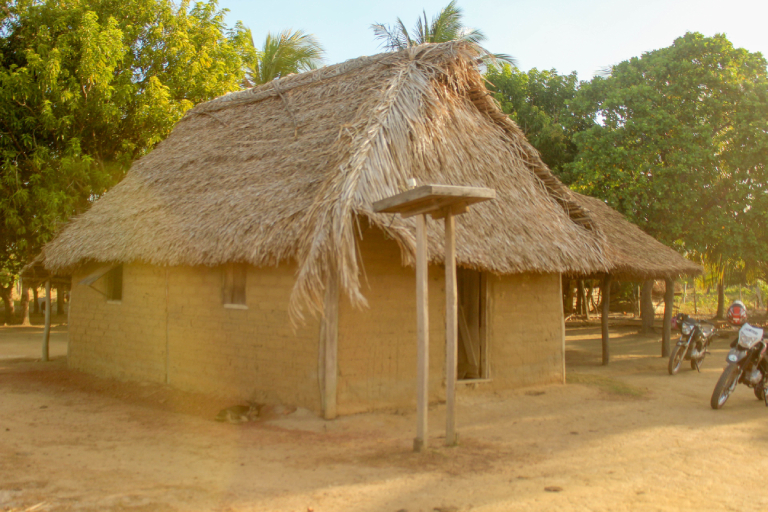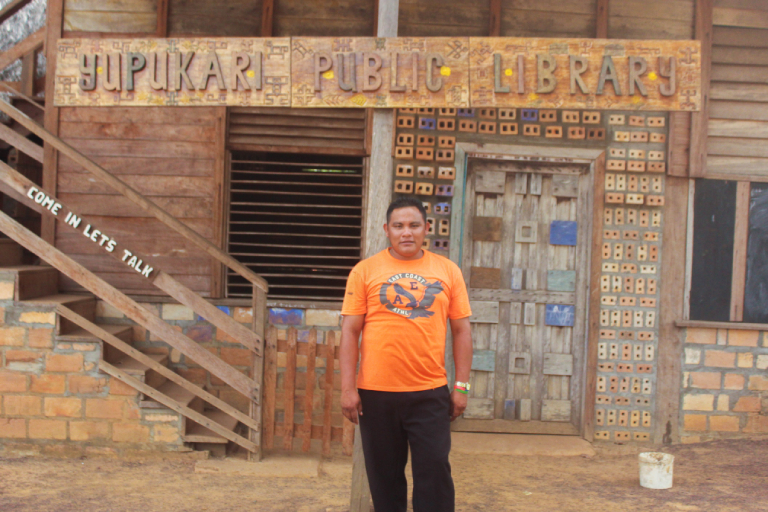- In Guyana’s sprawling Kanuku mountain range, indigenous villagers partner with researchers, scientists and conservation groups for support and to build upon their knowledge and capacity for conservation work.
- With traditional territory stretching to the northern border of Brazil, the Yupukari, Wapishana, and Macushi indigenous groups take the lead in conservation within their communities.
- The projects are managed through the Kanuku Mountains Regional Council, which was established to help oversee conservation in the 21 communities throughout the Kanukus.
YUPUKARI VILLAGE, Guyana — If Russian Dorrick is sure of anything, it’s that his community is capable of protecting their natural environment here in southern Guyana’s epic Kanuku mountain range.
The region is one of the most biodiverse in Guyana: one assessment in 2002 concluded that 70 percent of the country’s mammal species and 53 percent of the country’s known bird species live there. Spanning more than 5,000 square kilometers (2,000 square miles), the mountains are located in the heart of the Rupununi savanna.
Dorrick and his fellow inhabitants of Yupukari village live alongside the Wapishana and Macushi indigenous groups, who are spread out as far as northern Brazil. In Yupukari, indigenous villagers partner with researchers, scientists and conservation groups for support and to build upon their knowledge and capacity for conservation work.
“We don’t have people coming to run our house for us,” says Dorrick, Yupukari’s tashao, an elected indigenous official responsible for overseeing village concerns and development. “We are our own managers, our own scientists. We are the conservationists.”
The village’s base for this work is Kaiman House, founded for visiting researchers and conservationists in 2003 by Alice Layton. It also serves as the conservation center for the black caiman (Melanosuchus niger) and the yellow-spotted river turtle (Podocnemis unifilis).

Various other communities have also gotten involved with projects to educate their young people about wildlife, such as the North Rupununi Wildlife Program and the South Rupununi Bird Program. These are areas where endangered species such as the red siskin (Spinus cucullatus) and sun parakeet (Aratinga solstitialis) are monitored.
These projects are managed through the Kanuku Mountains Regional Council (KMRC), established to help oversee conservation in the 21 communities throughout the Kanukus. Through the creation of 10-year community plans, the KMRC has helped to sustain monitoring, environmental and resource management and strengthening of management systems in the various communities.
Designated as a protected area under Guyana’s laws, the Kanukus are the responsibility of the National Protected Areas Commission (PAC).
“When people hear the words ‘protected area’ they think it means you can’t use it at all,” Rudolph Robert, the KMRC program manager says in an interview. “So we often have to explain that you can still use it, but on a subsistence level.”
He adds that mistrust often arises out of confusion.

The indigenous experience
Camila George, a resident of Moco Moco village, says leaders often ignore indigenous voices when it comes to conservation initiatives. Moco Moco is one of the first villages heading into the Kanukus, two villages away from Yupukari. “Our traditional methods of living birthed conservation, but there have been changes in the way we live due to outside people and this has affected it,” George says.
Thadaigh Baggallay, part of a two-person team sent by the Frankfurt Zoological Garden to work with the PAC, is responsible for training rangers and planning mapping exercises. Currently, the PAC is looking into the possibility of doing pilot resource projects.
“Yupukari is one of the communities we want to focus on,” Baggallay says. “We’re thinking of focusing on fish and right now we’re working along with the community to come up with some possible rules to be put in place.” Some strategies being considered include the banning of seine nets for three months per year and stopping the use of all poisons in the rivers.
“It is up to us to care for our land and ensure that when we leave, we leave it in a better state than we met it. That is the goal,” says Dorrick, one of the youngest tashao in Yupukari’s history. He says he’s optimistic about the future of conservation in the community, but says the lack of funding severely limits the scope of the work they’re able to do.

According to Dorrick, the community has tagged and marked more than 800 black caimans during the course of the caiman project. Beginning in 2001, the caiman project has a yearly target of tagging 60 of the crocodilians, but a healthy population often results in the capture of more than 100 caimans. The species’ conservation status on the IUCN Red List was marked “lower risk” when it was last updated in 2000.
But Dorrick claims the black caiman population has declined in recent years. “When we started we had endless numbers, but they are fewer now,” he says.
Ecologist Peter Taylor, who helped set up Kaiman House and has studied Yupukari’s black caimans extensively, attributes the decline to the rapid extermination of the Orinoco crocodile (Crocodylus intermedius) by hunters.
“Once the population decreased significantly, then the black caiman became the next target” for these hunters, Taylor says. After exploiting most of the black caimans in Brazil, the next target became Guyana, with Yupukari the new point of exploitation.
Taylor first spotted black caimans in Yupukari during an academic trip through Guyana’s hinterlands in 1997 with Godfrey Bourne, co-founder of the Ceiba Biological Center, which does environmental research and training. In 2001, he returned to do a feasibility study on whether the black caiman population was significant enough for research.

“It was a really productive trip and we [floated] the idea of building a research station there for several months to study the black caimans,” he says.
The researchers would eventually form partnerships with the indigenous population in Yupukari to build a sustainable, long-term pilot project aimed at working with other scientists to gather data and build the community’s capacity for conservation.
Turtle porridge
Yupukari is already known for another conservation project, this one centered on yellow-spotted river turtles. In many indigenous communities, the turtles have been overharvested for their meat, Dorrick says. Turtle porridge is a frequent dish in the numerous cultural celebrations observed by indigenous people in the region.
Started by U.S. volunteer Jeffrey Slockum, the turtle conservation project has led to more than 1,000 turtles being incubated, grown and released back into their natural habitats by indigenous researchers.
“First we used to just do markings to go and check on them, but these often led people straight to the turtles,” Dorrick says. “So we started digging [patches of sand] but then red ants came and ate some so we didn’t have enough hatchlings. It’s a learning process, where local people become scientists on their own.”

With a survival rate of only 25 percent, extra care is needed when dealing with the turtles as they are very vulnerable as hatchlings. Using camera traps, the team monitors the eggs during the incubation period to ensure they are kept at a certain temperature and that they are not disturbed by predators.
After hatching, the yellow-spotted river turtles, also known as yellow-headed side-neck river turtles, are given names and cared for until they reach one year of age, at which point they are released back into the river. New eggs are collected every January, depending on weather conditions.
Local wildlife researcher Raul Lawrence says the conservationists make sure to let the people know what it is they’re doing and why, to ensure their conservation efforts connect with the local population.
“We tell people what we’re doing so that when they go back to their communities, they can incubate by themselves,” Lawrence says. “It makes no sense doing all of this and releasing them in to the wild only to have people kill them. So we invite communities and host sessions with villagers to let them know the importance of sustaining wildlife. If you make people aware of the importance of conservation, they will understand. Some bring their incubated turtles to the turtle festival.”
Depending on water levels, the turtle festival occurs in either April or May, and has contributed to Yupukari’s cachet as an ecotourism center.
“Following the success we’ve had with nesting, hatching and monitoring, people wanted to see what we were doing,” Dorrick says. “Tourism really came as a by-product of conservation. We had naturalists and birdwatchers coming but it was mainly the caiman project that brought people. The thing about research education and conservation is that tourism can be tied neatly up with it. We are conservationists and scientists. We do everything on our own here.”
Tourism decline
But these hard-earned achievements in both research and nature tourism have taken a hit since the cancellation in 2015 of all flights into the village of Annai, the main gateway to many of the communities in the region, including Yupukari.

Now, those wishing to visit Yupukari and other communities need to seek transportation from the town of Lethem, nearly 120 kilometers (72 miles) farther away than Annai, which is too expensive for many.
Layton, the Kaiman House founder, says they’ve seen a difference in the visitors who do arrive as a result of the cancelled flights.
“Now we’re mainly getting wealthy people,” she says. “Before we used to get students, backpackers, but when you make it that difficult and expensive you’re only going to get wealthy people.”
Banner image: Turtles in the conservation project in Guyana. Photo courtesy Ereika DeAndrade.
